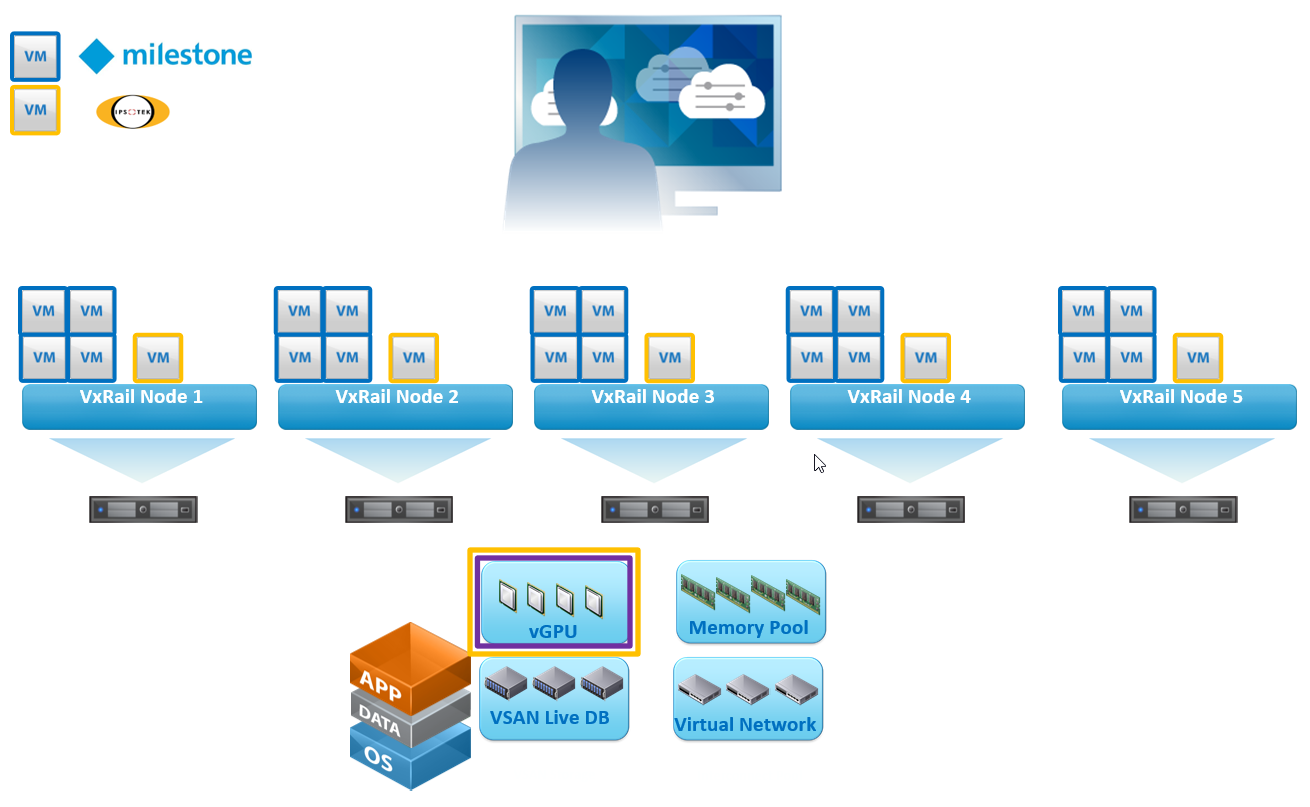Home > Workload Solutions > Computer Vision > Guides > Design Guide—Flexible Computer Vision Solutions with Dell APEX Infrastructure > Physical architecture
Physical architecture
-
Compute
In order to meet the requirements for performance, maintainability, and horizontal scalability, the solution is built using a Dell APEX Private Cloud 5-node cluster. This cluster is based on the 2U VxRail V670F platform with NVIDIA GPU support. It is also configured with all flash drives for optimal performance.
Milestone XProtect Systems provided the VMS functionality for our solution and Ipsotek provided the CV functionality. In a full production environment, there are trade-offs to consider when designing the initial placement and any use of automation for maintaining reliable operations. This guide describes what we validated in our lab environment. Please consult with all software suppliers and any system integrators prior to implementing a production-grade safety and security system.
The base hardware specs are as follows:
Table 1. Base hardware specs per node
CPU
2 x Intel® Xeon® Platinum 8368 CPU @ 2.6 GHz (64 cores)
Memory
512 GB
Storage
6 x 3.84 TB SSD drives
GPU
2 x A16 64 GB NVIDIA GPU or
2 x A40 48 GB NVIDIA GPUNetwork
The following table describes the networks that are configured as part of the validated design:
Table 2. Networks for the validated design
Network
Description
vSphere Management
Used by ESXi for host management
vMotion
Used by ESXi for vMotion
vSAN
Used by ESXi for vSAN traffic
User
Used for user access to applications running on VxRail
Camera
The camera network isolates camera traffic so only specific applications receive video streams
Storage
To optimize performance, application access to data storage is gained using a storage-only network
By configuring separate networks for the different traffic types, we get an additional layer of security and performance improvements.
Storage
The solution design uses two storage technologies:
- VMware vSAN for virtual machine disks, and Milestone Tier 1 storage
- Dell APEX Data Storage Services - File (PowerScale) for VMS video archiving
vSAN for VM local disks
The Dell APEX Private Cloud cluster was configured with vSAN datastores that are available for local disk mapping by all the VMs running on the cluster. The vSAN storage was configured with a RAID 5 storage policy to provide fault tolerance for all the applications writing to vSAN storage. This protection level maximizes the storage capacity while providing protection against a node failure.
The vSAN storage was used for all disks needed by Milestone Systems XProtect, and Ipsotek VMs, including the operating system and any local file locations. This includes all processing and management VMs needed by each of the software solutions.
The vSAN was also used for Milestone Systems Tier 1 storage. This storage is written to vSAN storage and then archived to Dell APEX Data Storage Services long term file-based storage.
Dell APEX Data Storage Services for bulk video stream archive
Dell PowerScale based Dell APEX Data Storage Services capacity optimized tier can store large volumes of video data that must be safely retained based on the needs of the customer and was used in this design for the video stream archive.
Shares on the Dell APEX Data Storage Services file system were set up as Continuous Availability (CA) shares. The SMB network protocol is used between the Milestone Systems XProtect and the storage. File shares are defined as CA shares and use the SMB3 Witness protocol. The witness protocol enhances client failover for SMB3 CA shares. Witness notifies the Expansion Server when a Dell APEX Data Storage Services file node becomes unavailable without the need to wait for the SMB3 connection time out. This storage is also responsible for responding to requests for retrieving historic video data for analysis by CV applications.
For more information about Dell storage options with Milestone, see Configuration Best Practices—Dell Storage Solution with Milestone XProtect Corporate.
Architecture
The high-level architecture is as follows:

Figure 1. Overall solution architecture using Dell APEX compute and storage
This design augments the HA support provided by each application by placing selected VMs and services for each vendor across the cluster. Some components of a complete VMS and CV solution, such as the cameras and Control Room shown in Figure 1 are not described in this design document but can easily be integrated with the solution.
